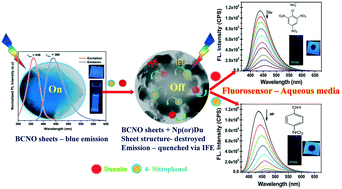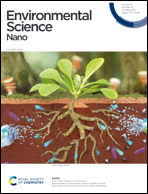Highly fluorescent 2D-BCNO sheets based chemical sensor for selective detection of the explosive Dunnite and 4-nitrophenol in aqueous medium†
Abstract
Highly fluorescent 2D-BCNO (boron carbon oxynitride) sheets were synthesized via a new facile and simple approach for selective and sensitive detection of nitro-aromatic compounds, namely 4-nitrophenol and Dunnite, in aqueous medium. 2D-BCNO sheets exhibited strong blue fluorescence emission in aqueous medium. The detailed photophysical properties and pH-dependent studies were performed. 2D-BCNO sheets showed a high fluorescence quenching towards explosive nitro-analytes and showed an unprecedented selectivity for Dunnite and 4-nitrophenol with a limit of detection (LOD) of 2.1 and 0.22 ppb respectively. The remarkable sensitivity during the fluorescence quenching phenomena arose due to the unique inner filter effect (IFE) and photo-induced electron transfer process through electrostatic interactions. The promising results from real-time sample analysis of river and tap water as well as interference studies in the presence of other nitro-analytes elucidated the potential practical application of sensor technology based on the 2D-BCNO sheets. Furthermore, the rapid and visual identification of Dunnite and 4-nitrophenol at picogram levels with a contact mode approach on solid substrates demonstrated that the developed sensor technology is suitable for onsite field analysis.



 Please wait while we load your content...
Please wait while we load your content...